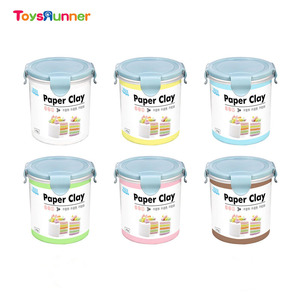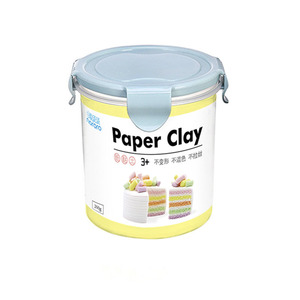(10184 products available)
























































































































































































Paper clay is a versatile material used in arts and crafts and has several varieties to suit different purposes. Here are some common types:
Traditional Paper Clay
This type of paper clay is ideal for hand-building and sculptural works. It is made by mixing paper pulp with earthenware or stoneware clay. This process enhances the clay's malleability and reduces weight. Furthermore, it has a high level of workability and is suitable for intricate details and large sculptures.
Paper Mache Clay
This type of paper clay is popular for paper mache projects. It has a lightweight and flexible nature, making it suitable for masks, puppets, and other forms with delicate structures. Usually, it is made by combining paper pulp with a paste of flour or glue and water.
Porcelain Paper Clay
This type of paper clay is designed for use with porcelain. It allows for the addition of paper pulp to increase workability and reduce shrinkage. This type of paper clay is ideal for delicate, translucent pieces like pottery and figurines. Additionally, it is commonly used in conjunction with other materials to enhance their properties.
Air-Dry Paper Clay
Air-dry paper clay does not require a kiln for drying. Therefore, it is useful for projects where access to a kiln is limited. Usually, it is formulated with a self-hardening resin that allows the clay to dry and harden when exposed to air. Additionally, it is mainly used for decorative items, jewelry, and other small crafts.
Modeling Paper Clay
This type of paper clay is used for detailed modeling and sculpting work. It is a fine, smooth-textured clay that makes it easy to create intricate details and delicate features. Moreover, it is ideal for creating figurines, miniatures, and other highly detailed pieces.
Construction Paper Clay
This type of paper clay is used for larger, structural pieces. It has a coarser texture and is more robust than modeling paper clay, making it suitable for building sculptures, pottery, and other functional items.
When choosing paper clay for a business, consider the forms the medium is available in. It can be in different forms, such as air-dry modeling clay, sculpting clay, or papier mache pulp. The forms available will determine how customers will use the clay. Also, the paper clay may come in various colors. Buyers should choose a type with a broad color selection to give customers an opportunity to choose their preferred colors. They should also look for a type that can easily be painted after drying to enhance its versatility.
Different projects require different paper clay strengths. For instance, light and delicate work doesn't need strong paper clay. At the same time, heavy projects require strong paper clay. Therefore, buyers should choose a type with varying strengths to cater to different customers' needs. Paper clay dries to varying rates depending on its composition and the environmental conditions. Therefore, buyers should choose a type that dries quickly and one that dries slowly to give customers an opportunity to choose what they prefer.
Paper clay can be used for various applications, such as arts and crafts, school projects, and home repairs. Therefore, buyers should get a versatile medium that can be used for different applications. To enhance the usability of the paper clay, buyers should also get a type that can easily be molded to different shapes and designs.
Most times, people use paper clay with other materials, such as adhesives and paints. Therefore, buyers should get a compatible type that can easily be combined with other materials. The paper clay type chosen should also be easy to clean. This will make it easy for users to wash their hands and tools after using the medium. If targeting kids, the paper clay should be safe for them and easy for them to use. It should also come with instructions on how to use it.
Finally, buyers should consider the cost of the paper clay and its quality. They should get a type that offers value for money and is durable.
Paper clay is a versatile material that artists and crafters can use for several applications. It combines traditional clay with paper pulp, making it more adaptable and durable. One of its primary uses is in art and pottery. It is because it allows for the creation of intricate sculptures, pots, and other artistic pieces. Additionally, its lightweight nature makes paper clay ideal for crafting masks, dolls, and other ornamental items.
Paper clay also finds its purpose in educational activities. Schools and workshops often employ it as a teaching tool for students to learn about sculpture, pottery, and three-dimensional design. Its malleability and ease of use make it suitable for hands-on learning experiences, fostering creativity and fine motor skills development.
Features of paper clay include its enhanced strength due to the paper pulp inclusion, which provides additional support and prevents cracking during drying and firing processes. The lightweight nature of paper clay is another distinguishing feature, making it easier to handle and transport. Moreover, its smooth and pliable texture allows for detailed work and seamless blending, catering to the needs of artists seeking precision in their creations.
Designs of paper clay creations are diverse, reflecting the artistic vision and functional requirements of the creators. Intricate patterns, textures, and shapes can be achieved due to the material's versatility and adaptability. Paper clay's lightweight nature also permits the creation of large-scale pieces that would be impractical with traditional clay due to their weight.
Paper clay is a popular medium due to its safety for various age groups and applications. Here are some key safety features:
When evaluating quality features of paper clay, consider the following:
Q1: What is paper clay used for?
A1: Paper clay is versatile and used for making sculptures, pottery, and crafts.
Q2: Is paper clay air-dry?
A2: Yes, some types of paper clay, like paper mache clay, dry out without ovens.
Q3: How is paper clay colored?
A3: Users can add pigments, paints, or glazes to paper clay for decoration.
Q4: What makes paper clay lightweight?
A4: The inclusion of paper fibers and pulps makes the paper clay lightweight.
Q5: Can paper clay be recycled?
A5: Yes, paper clay is eco-friendly and can be recycled or composted when unused.